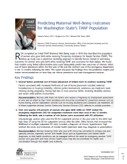This study uses a predictive modeling approach to identify factors related to well-being outcomes for women who give birth while receiving TANF, and outcomes for their babies. We found that models using linked administrative data could adequately predict two outcomes of interest: infant out-of-home placement within the first year of life and the mother’s use of the emergency department in the 12 months following the birth. This report discusses the findings from the predictive models and makes recommendations on how they can inform prevention and case management services.
Report and/or Additional Information:
Categories:
Related Publications:
- Home Visiting Services for TANF Families with Young Children (6.58)
- Home Visiting Services for TANF Families with Young Children: First Year Outcomes (6.61)
- Home Visiting Services for TANF Families with Young Children: Second Year Outcomes (7.117)
- Identifying Infants at Risk of Adverse Outcomes Using Administrative Data: Findings from Washington State (7.115)
- Service Use, Risk Factors, and Assessments among ECLIPSE, ECEAP, and ESIT Clients (7.114)
- State and County Estimates of the ECLIPSE Eligible Population (7.112)
- The ECLIPSE Program at Childhaven (7.110)
- The Maternal Well-Being of Washington State’s TANF Population (6.64)

